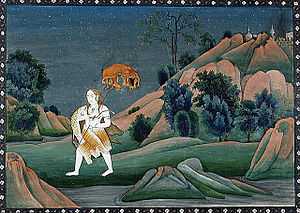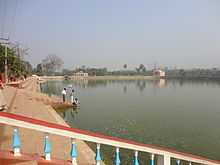Tripura Sundari Temple
| Tripura Sundari Temple | |
|---|---|
 | |
| Name | |
| Proper name: | Tripura Sundari Temple (Matabari) |
| Location | |
| Country: | India |
| State: | Tripura |
| Location: | Udaipur, 55 km from Agartala |
| Architecture and culture | |
| Primary deity: | Tripura Sundari (Lalita) |
| Architectural styles: | Bengali |
| History | |
| Date built: (Current structure) | 1501 |
| Creator: | Maharaja Dhanya Manikya Debbarma |
Tripura Sundari Temple is situated in the ancient Udaipur, about 55 km from Agartala, believed to be one of the holiest Hindu shrines in this part of the country. Popularly known as Matabari, crowns in a small hillock and is served by the red-robed priests who traditionally, minister to the mother goddess Tripura Sundari. Considered to be one of the 51 Shakti Peethas, consists of a square type sanctum of the typical Bengali hut. It is believed that Sati's right foot fell here during Lord Shiva's Nataraj Dance. The temple consist a square type sanctum with a conical dome. It was constructed by Maharaja Dhanya Manikya Debbarma in 1501, there are two identical images of the same deity inside the temple. They are known as Tripura Sundari (5 feet high) and Chhotima (2 feet high) in Tripura. The idol of Maa Kali is worshiped at the temple of Tripura Sundari in the form of 'Soroshi'. One is made of kasti stone which is reddish black in colour. It is believed that the idol was Chhotima was carried by king in battlefield. This temple is also known as Kurma Pitha because it the temple premises resembles kurma i.e. tortoise. Every year on Diwali, a famous Mela takes place near the temple which is visited by more than two lakhs pilgrims. (Information presented by Dr. Kamal Majumdar, Rajarbag, Udaipur. New info will be added soon)
There is another shrine for Tripura Sundari at madambakkam, near chennai, about 15 km from Chennai airport via tambaram selaiyur camp road.
Tripurasundari is worshipped as Sapari vara srichakra mahameru Lalithatripurasundari at 18 siddar universal shrine for worship at madambakkam near chennai, she is the presiding deity, the maha meru is made out of a single green color granite (pachai kal), this shrine founded by Guruji KVLN Sharmaji is open to all irrespective of caste, creed, religion. The 18 siddar Sree Lalithatripurasundari universal shrine is at 1 sannadhi street, madambakkam, near Rajakilpakkam (5 km from tambaram selaiyur -rajakilpakkam junction) in chennai. Sathguru Sri Seshadri swamigal worshipped Devi Sri Lalithatripurasundari in SriVidya culture.[1]
Legend
Legend has it that king Dhanyamanikya who ruled Tripura in the closing years of the 15th century, had a revelation one night in his dream, ordering him to install Goddess Tripurasundari in the temple that stood on a hilltop near the town of Udaipur. The temple was already dedicated to Lord Vishnu, and the king was confounded initially, unable to decide how a temple dedicated to Vishnu could have an idol of the consort of Shiva. However, the oracle repeated the divine injunction to the king once again the following night, thereafter the ruler decided to obey the ethereal command, notwithstanding the fact that Vishnu and Shiva typified two different sects of religious following. Thus, the Tripura Sundari temple came into being in around the year 1501, and is now about 500 years old. This legend is recounted as one of the example of how solidarity between the two sub groups, the Vaishnava and Shaiva sects, was known and fostered even during medieval times.
About The Temple
Goddess Parvati (also spelt as Partvathi) is worshipped here as Tripurasundari, Tripureshwari and "Soroshi" (a local variation of the name). The temple is a small, square edifice, measuring just 24 square feet (7 square metres) at the base with a height of 75 feet (24m approximately). The structure of the shrine resembles that of a tortoise, with a roof shaped like the humped back of a tortoise. For this reason, the shrine is also known as "Koorma Peetha" (Koorma meaning Tortoise). As in other typical Hindu shrines, stalls along the approach road sell flowers and baskets of offerings that visitors can buy and take up to be offered to Tripura Sundari and returned as Prasadam. A specialty here is the sweet, brown, condensed milk Pedas that devotees carry back from the temple, to be distributed among family and friends back home. The red hibiscus flower is also prized as an offering.
The Temple as a Shakti Peeth - Daksha Yaga and Sati's Self Immolation

The mythology of Daksha yaga and Sati's self immolation had immense significance in shaping the ancient Sanskrit literature and even had impact on the culture of India. It led to the development of the concept of Shakti Peethas and there by strengthening Shaktism. Enormous mythological stories in puranas took the Daksha yaga as the reason for its origin. It is an important incident in Shaivism resulting in the emergence of Shree Parvati in the place of Sati Devi and making Shiva a grihastashrami (house holder) leading to the origin of Ganapathy and Subrahmanya.[2][3][4]
Shakti Peethas are shrines or divine places of the Mother Goddess. These are places that are believes to have enshrined with the presence of Shakti due to the falling of body parts of the corpse of Sati Devi, when Lord Shiva carried it and wandered throughout Aryavartha in sorrow. There are 51 Shakti Peeth linking to the 51 alphabets in Sanskrit. Each temple have shrines for Shakti and Kalabhairava and mostly the each temple associates different names to Shakti and Kalabhairava in that temple.
Kottiyoor Vysakha Mahotsavam, a 27 day yagnja ceremony, conducted in the serene hilly jungle location in North Kerala yearly commemorating the Daksha Yaga. It is believed that Sati Devi self immolated in this location and apparently this is the location of Daksha Yaga. The rites and rituals were classified by Shri Sankaracharya.[5]
Tourist Attraction
All though the shrine draws devotees of all denominations and sects all year round (including some foreigners who are fascinated by the tribal heritage of Tripura and adjacent states of the Northeast, the crowds are particularly thick during Deepavali or Diwali (festival of lights), when a major fair turns the place into a tourist attraction.
Animal Sacrifice
The offering of animal sacrifices (as in Bengal and in the famous Kamakhya temple in Guwahati)is a very popular custom. Goats are brought with garlands round their necks, as offerings. A notice board lists the charges for buffalo sacrifices, but these are obviously rare today. There are elements here of the Durga cult and rites, so popular in the eastern regions including Bengal, signifying an aggressive manifestation of the goddess as against the "Shanta-Swaroopini" image of Parvathi's incarnations, as at Madurai, for instance.
Kalyan Sagar

Kalyan Sagar lies in the eastern side of the temple. Spreading over 6.4 acres, with a length of 224 yards and width of 160 yards this large expanse of water adds a dimension of great beauty to the temple precincts, with hills rising picturesquely in the background. The water is full of Tortoises, some of them quite large, that come up to the shore looking for crumbs of food that visitors buy at the nearby stalls and feed to these reptiles, as part of the rituals. Devotees feed them with "muri" and biscuits. Fishing is not permitted in the Kalyan Sagar. A big lake Kalyan Sagar just down to the Hillock at the backside of the Temple adds to its beauty. This natural pond has varieties of aqua species. The area of the Kalyan Sagar Lake is 2.752 acre. The lake is considered sacred and devotees worship the fishes and tortoises present here. Kalyan Sagar is famous for very rare species of tortoise in large numbers. The Matabari Temple Committee is cementing the banks of Kalyan Sagar Lake for the last 2–3 years. The water of the lake became acidic due to destruction of the ecosystem around the lake. This has resulted in death of tortoise, as the cemented embankments spoiled the natural habitat as well as places for laying eggs for this turtles. As an amphibian it is extremely essential for the tortoise to have sandy exposure, which is not available in the lake after the construction of walls around the water body. Death of at least 7 tortoise have been reported in the last 6 months. Carrying of plastic poly bags are banned in and around Matarbari Temple area since 1998, even before the banning order issued by Tripura State Pollution Control Board (TSPCB) for the entire State of Tripura on 21 January 2002. But visitors, tourists, pilgrims and devotees are throwing plastic carry bags every day into the lake. As a result the bed of the lake is now full of polythene/plastics bags. To assess the situation and the state of the natural habitat of the tortoise, a team of TSPCB consisting of Scientist and Engineer visited the lake and interacted with the local people on March 22, 2003. To check the water quality of the lake, TSPCB collected water samples from four locations of the lake and analyzed the different parameters of the water quality. The results of the study show that the water quality of the lake is very good and even drinkable. According to the experts, it is only the construction of the embankments that increased the mortality of the turtles.
References
- ↑ "SATHGURU SRI SESHADRI SWAMIGAL BRINDAVANAM TRUST". seshadri.info. Retrieved 2014-01-25.
- ↑ (Translator), F. Max Muller (June 1, 2004). The Upanishads, Vol I. Kessinger Publishing, LLC. ISBN 1419186418.
- ↑ (Translator), F. Max Muller (July 26, 2004). The Upanishads Part II: The Sacred Books of the East Part Fifteen. Kessinger Publishing, LLC. ISBN 1417930160.
- ↑ "Kottiyoor Devaswam Temple Administration Portal". http://kottiyoordevaswom.com/. Kottiyoor Devaswam. Retrieved 20 July 2013.
- ↑ Kottiyoor/ "Sri Kottiyoor". Sri Kottiyoor. 2013. Retrieved 26 July 2013.
External links
- Details about the Temple
- Mata Bari Temple
- shreetripurasundari Temple in Rajasthan
- "SATHGURU SRI SESHADRI SWAMIGAL BRINDAVANAM TRUST". seshadri.info. Retrieved 2014-01-25.
| |||||||||||||||||||